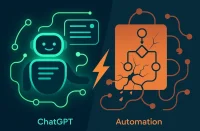How to build systems to actually achieve your goals
How to build systems to actually achieve your goals is the question every busy professional faces. How do you balance working full-time with constantly learning and upskilling while getting enough sleep, exercising, taking care of your health, spending time with loved ones, and having free time for hobbies? Is that even possible?
Yes, it is. But only if you think in systems. After over a decade of coaching thousands of professionals to learn efficiently and succeed in their careers while maintaining work-life balance, I’ve discovered that thinking in systems is the secret to regaining control and freedom. It’s what prevents you from being stuck on the hamster wheel of constantly feeling busy while not making progress on the things you really care about.
In this comprehensive guide, I’ll explain what thinking in systems actually means and share the simple framework I use when coaching clients to build systems for their own goals.
What does thinking in systems actually mean?
Thinking in systems means reducing your reliance on willpower and motivation. Instead of depending on these unreliable forces, you build processes that automatically help you achieve the results you’re looking for. Once you find processes that work, you chain them together to create a system.
Most people don’t think in systems. They operate in terms of intentions and tasks: “I need to exercise today,” “I need to get more sleep,” or “I need to finish that course.” But when you’re busy, it’s difficult to turn these intentions into reality.
If you’re more proactive, you might turn these intentions into plans: “I’m going to spend an hour every evening reading” or “When I get home from work, I’m going to exercise every day.” But what happens when you’re too tired? What happens when something comes up? What happens on day three when you realize you haven’t even started yet?
At this point, you feel frustrated and disappointed because yet again, your plans haven’t come to fruition. This is where systems thinking becomes crucial.
The 3 principles of systems thinking
There are three core principles that will help you build effective systems for any goal. These principles work together to create sustainable, repeatable processes that don’t rely on willpower or motivation.
Principle 1: Think holistically
When thinking in systems, you look at your intention and consider all the factors that would influence the success of that goal. You proactively expect your plan to fail. You expect to be tired, lazy, and for things to come up. Then you ask yourself: “What can I do about that?”
When I’m coaching someone to build their own systems, one of the first things I do is ask them about all the things they’ve tried in the past and why those didn’t work. I pay close attention to what they did and how they responded to obstacles or challenges.
This step is crucial because you need a comprehensive list of all possible barriers. There’s a high chance that the system you create will have to account for all these factors.
Principle 2: Build for repeatability
You don’t want to develop a system that relies on all the stars aligning. You want it to work on the worst day. If you think about your intention and the plans you’ve made, you can evaluate these plans in terms of how repeatable they are on a bad day.
Ask yourself: “Does this plan rely on willpower or motivation for me to execute it?” For the overwhelming majority of people, most plans require injecting motivation and willpower to make them happen. This violates the second principle of building for repeatability.
You want to make sure there is as little friction as possible. When you work with these two principles, you end up cycling back and forth between them. You figure out something that requires high effort (meaning you’ll rely on willpower), then you think about ways to avoid that. “What are ways I can make this easier?”
Then you go back and ask: “What are the challenges, obstacles, and other factors that might make this plan not work?”
Principle 3: Peel the band-aids
Your first system will be full of band-aid solutions. These are temporary fixes that help you in the short term without addressing underlying issues. For example, if you’re always tired and struggle to focus, your first solution might be to take a nap during the day and use a timer when working.
These are band-aid solutions because they help you right now without addressing the root cause. The reason you’re tired is because you’re not getting enough sleep. The reason you can’t focus is because your attention span needs work.
While band-aid solutions can serve you in the short term, they overcomplicate your system. If possible, you want to remove the limitations and conditions for success. What if you don’t have time for a nap? What if you don’t have a timer available? In those cases, your plan fails for that day.
Band-aid solutions should be temporary while you work on solving underlying problems. Often, working on these underlying issues involves changing habits, which takes time. The act of changing your habits to eventually remove band-aid solutions should become part of your system.
A real-world example: The accountant studying for CA exams
Let me share a real example of how these principles work together. I was working with an accountant who was studying for their chartered accountancy exams while working full-time. Their initial plan was to study every day after work as soon as they got home.
This plan failed constantly because there was too much traffic, they got tired on the drive home, and when they got home, there was family time, dinner preparation, and they were too tired and sleepy to study. They just wanted to relax.
The common solution would be to say, “Just dig deep and try harder. Forget it if you’re tired. Just do it anyway.” While this can work for a period, it’s not sustainable and not a pleasant way to live every day.
Instead, when we applied systems thinking holistically and for repeatability, we looked at the problem differently. We asked: “What can we do about this?”
One solution was to stay at work longer after work, beat the traffic, do the studying in the office, then come home afterward. This reduced effort and tackled barriers like feeling too tired and not having enough energy.
Then we went back and thought: “What are the reasons why this might not work?” In this case, if they came home that late, the entire family would have to push back their dinner time. Could that work? Maybe they could have a conversation with their family and push back dinner by an hour.
We also explored another option: studying before work in the morning. The issue was they wouldn’t get enough sleep. Could they sleep earlier? Maybe they could change their nighttime routine to make that happen.
We constantly bounced back and forth between looking for low-effort solutions and thinking about all the reasons why they might not work until we arrived at a combination that locked in success.
The key insight: It’s a series of problems to solve
What’s really important with this process is thinking about it as a series of problems to solve. Just because your first solution isn’t perfect doesn’t mean there is no solution. There is some combination of solutions that will work. Your role when thinking in systems is to look for that combination until you figure it out.
This is a process I’ve repeated hundreds of times, which eventually allowed me to work full-time as a doctor while running a business full-time and doing my master’s full-time while going to the gym, having a social life, spending time with my family, and getting 8-9 hours of sleep every night.
Often, one of the biggest things I do when coaching someone is simply being more committed to looking for that solution for longer than they normally might. The solution we come to from this thinking process often involves a certain level of discomfort, but this is actually fine. In fact, it’s a good thing.
The fact that a solution feels uncomfortable means it’s different than what you’re used to doing, and getting a different result is the whole point of thinking in systems. The discomfort of making the change and acting on the solution is often not as bad as the discomfort of not making the change.
It may be uncomfortable to change your nighttime routine so you can sleep one or two hours earlier. Yes, that’s uncomfortable. But it’s not uncomfortable versus comfortable. It’s uncomfortable versus even more uncomfortable because if you don’t make those changes, you have to live with the stress, pressure, anxiety, and disappointment of never making meaningful progress on the things that matter to you.
How systems thinking transforms your approach
As you go through this process and bounce back and forth between these principles, you’ll find that your intentions and plans become much clearer and more specific. Your plans aren’t just general statements about doing something at a certain time. They cover contingencies:
- If I’m tired, I’m going to do this
- If I’m not tired, I’m going to do this
- If something comes up, I’ll handle it this way
You’ll learn so much about yourself and how you respond to different challenges that you’ll also learn how to make it easier for yourself to do the things you need to do. The way you follow your plans and create habits becomes much more fluid and dynamic, adapting to the unexpected challenges of life rather than having a rigid approach that constantly butts up against reality and only holds up through unwavering willpower (which will waver).
Building systems for different types of goals
Learning and upskilling systems
For busy professionals who need to constantly learn and upskill, the key is to create systems that work with your existing schedule rather than against it. This might involve:
- Micro-learning sessions during commute time
- Audio learning during exercise
- Focused study blocks during lunch breaks
- Weekend deep-dive sessions for complex topics
Invest in Your Growth
Building the right system for learning and upskilling can transform your career. Whether it’s micro-learning, weekend deep dives, or structured career moves, the key is aligning your efforts with real opportunities.
Search Jobs That Match Your Skills →Health and fitness systems
When building systems for health and fitness, consider:
- Workout times that align with your energy levels
- Meal prep systems that work with your schedule
- Sleep optimization strategies
- Exercise routines that can be done anywhere
Relationship and family systems
For maintaining relationships while pursuing goals:
- Quality time blocks that are non-negotiable
- Communication systems that keep everyone informed
- Shared activities that serve multiple purposes
- Boundary-setting strategies that protect family time
Common mistakes when building systems
1. Overcomplicating from the start
Many people try to build the perfect system immediately. Start simple and iterate. Your first system doesn’t need to be perfect; it just needs to work.
2. Ignoring personal patterns
Don’t build systems based on what works for other people. Pay attention to your own energy levels, preferences, and natural rhythms.
3. Not accounting for obstacles
Every system will face obstacles. Build them into your planning rather than hoping they won’t occur.
4. Relying too heavily on willpower
If your system requires constant motivation to work, it’s not a good system. Look for ways to reduce friction and make actions automatic.
5. Not iterating and improving
Systems should evolve. Regularly review what’s working and what isn’t, then make adjustments.
How to get started with systems thinking
Step 1: Choose one goal to focus on
Don’t try to build systems for everything at once. Pick one important goal and focus on building a system for that first.
Step 2: List all the obstacles you’ve faced before
Think about all the times you’ve tried to achieve this goal in the past. What went wrong? What obstacles did you face? How did you respond to them?
Step 3: Brainstorm low-effort solutions
For each obstacle, think of ways to make the process easier. Look for solutions that require minimal willpower or motivation.
Step 4: Test and iterate
Try your system for a week or two. What worked? What didn’t? Make adjustments and try again.
Step 5: Remove band-aid solutions
Once your basic system is working, identify any temporary fixes you’re using and work on addressing the underlying issues.
The long-term benefits of systems thinking
When you master systems thinking, you gain several powerful benefits:
- Reduced stress: You’re not constantly relying on willpower and motivation
- Consistent progress: Your systems work even on bad days
- Better work-life balance: You can pursue goals without sacrificing other important areas
- Increased confidence: You know you can achieve your goals because you have a system
- More freedom: You’re not constantly thinking about what you should be doing
FAQs
Q: How long does it take to build an effective system?
A: Most people can build a basic working system in 1-2 weeks, but it takes 2-3 months to refine it and remove all the band-aid solutions. The key is to start simple and iterate continuously.
Q: What if I don’t have time to build systems?
A: This is exactly why you need systems! The time you spend building systems will save you much more time in the long run. Start with just 30 minutes to plan one system for one goal.
Q: Can systems work for creative or unpredictable work?
A: Yes! Systems for creative work focus on creating the right conditions for creativity to flourish, such as dedicated creative time, inspiration-gathering routines, and structured reflection periods.
Q: What if my system stops working?
A: This is normal and expected. Systems need to evolve as your life changes. When a system stops working, go back to the three principles: think holistically about what changed, rebuild for repeatability, and identify any new band-aid solutions to address.
Live example — user point of view
I used to be the classic busy professional who was constantly stressed and never making progress on the things that mattered to me. I had goals to learn new skills, get in shape, spend quality time with my family, and advance my career, but I felt like I was constantly running on a hamster wheel.
I’d make plans like “I’m going to study for an hour every evening” or “I’m going to work out every morning before work,” but these plans would fall apart within days. I’d be too tired, something would come up, or I’d just lose motivation. I felt like a failure and was constantly disappointed in myself.
Then I discovered systems thinking, and it completely changed my approach. Instead of relying on motivation and willpower, I started building processes that worked with my natural patterns and energy levels.
For learning, I realized I was most alert during my commute, so I started listening to educational podcasts and audiobooks during my drive. For exercise, I found that I had more energy in the evening, so I built a system around working out right after work before going home. For family time, I created non-negotiable blocks on weekends and found ways to involve my family in my learning goals.
The key was thinking holistically about all the obstacles I’d face and building solutions for them in advance. Instead of hoping I’d have willpower when I was tired, I created systems that worked even when I was exhausted.
It took about 3 months to get all my systems working smoothly, but now I feel like I have my life back. I’m making consistent progress on my goals without constantly feeling stressed or overwhelmed. The systems do the heavy lifting, and I just follow the processes I’ve built.
Most importantly, I’ve learned that discomfort is part of the process. The changes I made felt uncomfortable at first, but the discomfort of not making progress was much worse than the discomfort of changing my routines.




